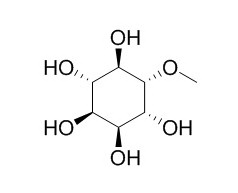L-Quebrachitol
L-Quebrachitol can as a sugar substitute for diabetics. Administration of sea buckthorn juice enriched in L-quebrachitol can increase fasting insulin level in plasma and show similar effects on random blood glucose level, glucose tolerance and the pancreatic tissue as observed for pure sea buckthorn juice.
Inquire / Order:
manager@chemfaces.com
Technical Inquiries:
service@chemfaces.com
Tel:
+86-27-84237783
Fax:
+86-27-84254680
Address:
1 Building, No. 83, CheCheng Rd., Wuhan Economic and Technological Development Zone, Wuhan, Hubei 430056, PRC
Providing storage is as stated on the product vial and the vial is kept tightly sealed, the product can be stored for up to
24 months(2-8C).
Wherever possible, you should prepare and use solutions on the same day. However, if you need to make up stock solutions in advance, we recommend that you store the solution as aliquots in tightly sealed vials at -20C. Generally, these will be useable for up to two weeks. Before use, and prior to opening the vial we recommend that you allow your product to equilibrate to room temperature for at least 1 hour.
Need more advice on solubility, usage and handling? Please email to: service@chemfaces.com
The packaging of the product may have turned upside down during transportation, resulting in the natural compounds adhering to the neck or cap of the vial. take the vial out of its packaging and gently shake to let the compounds fall to the bottom of the vial. for liquid products, centrifuge at 200-500 RPM to gather the liquid at the bottom of the vial. try to avoid loss or contamination during handling.
Biomedicines.2022, 10(2):463.
J Appl Biol Chem.2024, 67:39,281-288.
J Nat Prod.2018, 81(4):966-975
Research on Crops.2017, 18(3):569
J Pharmaceut Biomed2020, 182:113110
Bioengineering2023, 10(10), 1113.
J Microbiol Biotechnol.2024, 35:e2408022.
Nutr Cancer.2024, 76(3):305-315.
Trop J Pharm Res.2023, 22(3):283-288.
J Biol Chem.2014, 289(3):1723-31
Related and Featured Products
Journal of Functional Foods, 2015 ,16 :223-233.
Effects of sea buckthorn (Hippophaë rhamnoides) juice and L-quebrachitol on type 2 diabetes mellitus in db/db mice[Reference:
WebLink]
To study the effects of sea buckthorn juice and L-Quebrachitol on type 2 diabetes, db/db mice were given 10-week gavage administration of pure sea buckthorn juice or sea buckthorn juice enriched with L-Quebrachitol.
METHODS AND RESULTS:
Treatment with sea buckthorn juice reduced the feed intake, body weight gain, random blood glucose level, and the expression of insulin receptor β in the liver. Sea buckthorn juice significantly improved glucose tolerance and the integrity of pancreatic tissue. Administration of sea buckthorn juice enriched in L-Quebrachitol increased fasting insulin level in plasma and showed similar effects on random blood glucose level, glucose tolerance and the pancreatic tissue as observed for pure sea buckthorn juice.
CONCLUSIONS:
The results suggest hypoglycaemic effects of sea buckthorn juice in type 2 diabetic db/db mice, likely associated with improvement of pancreas and reversal of insulin resistance. L-Quebrachitol present in sea buckthorn might have contributed to the effects observed.
Carbohydr Res. 2008 Oct 13;343(15):2699-700.
First record of L-quebrachitol in Allophylus edulis (Sapindaceae).[Pubmed:
18715552]
Allophylus edulis, commonly called 'Chal chal', is a member of the Sapindaceae occurring in the Uruguayan and Brazilian native flora.
METHODS AND RESULTS:
During the phytochemical analysis of two Chal chal specimens from two well-differentiated geographical zones (Assis, São Paulo, Brazil, and Santa Lucía, Canelones, Uruguay), considerable amounts of L-Quebrachitol were isolated from both samples.
The isolation was carried out from the ethanolic twig extracts obtained by maceration of both vegetal samples. White easily distinguishable crystals were mechanically separated, washed, and characterized by 1D and 2D NMR experiments and by MS data.
CONCLUSIONS:
Such techniques confirmed that the crystals isolated from sources collected in both countries resulted in the same compound, L-Quebrachitol, a natural product not previously reported for this species and one that has been investigated as a sugar substitute for diabetics. Worthy of note, the content of L-Quebrachitol in A. edulis may be the chemical basis to explain its ethnobotanical uses, since infusions of this plant are used to treat diabetes in the practice of local traditional medicine.



